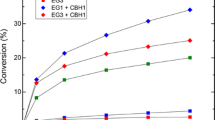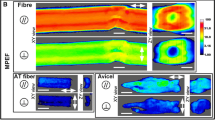Abstract
In this study, we developed a method to observe interactions between cellulase and cellulose microfibril by transmission electron microscopy. Although negative staining and low-angle metal shadowing increase image contrast, neither method is sufficient to view enzyme interactions with microfibril. However, we found that the combination of negative staining and low-angle metal shadowing provided better contrast for enzyme-like particles on the microfibril. The lengths of the particles interacting with microfibrils were 7.03 and 5.05 nm, parallel and perpendicular to the fiber direction, respectively. Accounting for the additional thickness owing to metal shadowing, the particle sizes were consistent with that of CBH I from Trichoderma reesei based on a crystalline structural analysis. The combination of these electron staining techniques successfully visualized morphological changes in microfibril as well as enzymes adsorbed on it, thus demonstrating cellulase in action. These results indicate that appropriate staining techniques can be applied to extend the applications of transmission electron microscopy, which may be particularly beneficial for studies on enzymatic behavior.





Similar content being viewed by others
References
Baker AA, Helbert W, Sugiyama J, Miles MJ (1997) High-resolution atomic force microscopy of native Valonia cellulose I microcrystals. J Struct Biol 119:129–138
Baker AA, Helbert W, Sugiyama J, Miles MJ (2000) New insight into cellulose structure by atomic force microscopy shows the Iα crystal phase at near-atomic resolution. Biophys J 79:1139–1145
Chanzy H, Henrissat B (1985) Undirectional degradation of Valonia cellulose microcrystals subjected to cellulase action. FEBS Lett 184:285–288
Chanzy H, Henrissat B, Vuong R, Schulein M (1983) The action of 1,4-β-d-glucan cellobiohydrolase on Valonia cellulose microcrystals: an electron microscopic study. FEBS Lett 153:113–118
Chanzy H, Henrissat B, Vuong R (1984) Colloidal gold labeling of 1,4-β-d-glucan cellobiohydrolase adsorbed on cellulose substrates. FEBS Lett 172:193–197
Divne C, Stahlberg J, Reinikainen T, Ruohonen L, Pettersson G, Knowles JKC, Teeri TT, Jones TA (1994) The three-dimensional crystal structure of the catalytic core of cellobiohydrolase I from Trichoderma reesei. Science 265:524–528
Gilkes NR, Kilburn DG, Miller RC, Warren RAJ, Sugiyama J, Chanzy H, Henrissat B (1993) Visualization of the adsorption of a bacterial endo-β-1,4-glucanase and its isolated cellulose-binding domain to crystalline cellulose. Int J Biol Macromol 15:347–351
Heinmets F (1949) Modification of silica replica technique for study of biological membranes and application of rotary condensation in electron microscopy. J Appl Physiol 20:384–388
Horikawa Y, Imai T, Abe K, Sakakibara K, Tsujii Y, Mihashi A, Kobayashi Y, Sugiyama J (2016) Assessment of endoglucanase activity by analyzing the degree of cellulose polymerization and high-throughput analysis by near-infrared spectroscopy. Cellulose 23:1565–1572
Igarashi K, Koivula A, Wada M, Kimura S, Penttila M, Samejima M (2009) High speed atomic force microscopy visualizes processive movement of Trichoderma reesei cellobiohydrolase I on crystalline cellulose. J Biol Chem 284:36186–36190
Igarashi K, Uchihashi T, Koivula A, Wada M, Kimura S, Okamoto T, Penttila M, Ando T, Samejima M (2011) Traffic jams reduce hydrolytic efficiency of cellulase on cellulose surface. Science 333:1279–1282
Imai T, Boisset C, Samejima M, Igarashi K, Sugiyama J (1998) Unidirectional processive action of cellobiohydrolase Cel7A on Valonia cellulose microcrystals. FEBS Lett 432:113–116
Kim NH, Herth W, Vuong R, Chanzy H (1996) The cellulose system in the cell wall of Micrasterias. J Struct Biol 117:195–203
Lee I, Evans BR, Woodward J (2000) The mechanism of cellulase action on cotton fibers: evidence from atomic force microscopy. Ultramicroscopy 82:213–221
Lehtio J, Sugiyama J, Gustavsson M, Fransson L, Linder M, Teeri TT (2003) The binding specificity and affinity determinants of family 1 and family 3 cellulose binding modules. Proc Natl Acad Sci USA 100:484–489
Rosgaard L, Pedersen S, Langston J, Akerhielm D, Cherry JR, Meyer AS (2007) Evaluation of minimal Trichoderma reesei cellulase mixtures on differently pretreated barley straw substrates. Biotechnol Progr 23:1270–1276
Shoemaker S, Watt K, Tsitovsky G, Cox R (1983) Characterization and properties of cellulases purified from Trichoderma reesei Strain L27. Biotechnology 1:687–690
Wang J, Quirk A, Lipkowski J, Dutcher JR, Clarke AJ (2013) Direct in situ observation of synergism between cellulolytic enzymes during the biodegradation of crystalline cellulose fibers. Langmuir 29:14997–15005
Wardrop AB, Melbourne SM (1968) The enzymatic degradation of cellulose from Valonia ventricosa. Wood Sci Tech 2:105–114
White AR, Brown RM (1981) Enzymatic hydrolysis of cellulose: visual characterization of the process. Proc Natl Acad Sci USA 78:1047–1051
Acknowledgments
We would like to express our appreciation to Dr. A. Hirai for providing the sample and Dr. Y. Kobayashi for providing the enzyme. This work was supported by a grant for Mission Research from the Research Institute for Sustainable Humanosphere (RISH) of Kyoto University and the Japan Society for the Promotion of Science (JSPS) KAKENHI Grant Number 15K18723.
Author information
Authors and Affiliations
Corresponding author
Rights and permissions
About this article
Cite this article
Horikawa, Y., Imai, T. & Sugiyama, J. Visualization of cellulase interactions with cellulose microfibril by transmission electron microscopy. Cellulose 24, 1–9 (2017). https://doi.org/10.1007/s10570-016-1105-9
Received:
Accepted:
Published:
Issue Date:
DOI: https://doi.org/10.1007/s10570-016-1105-9




